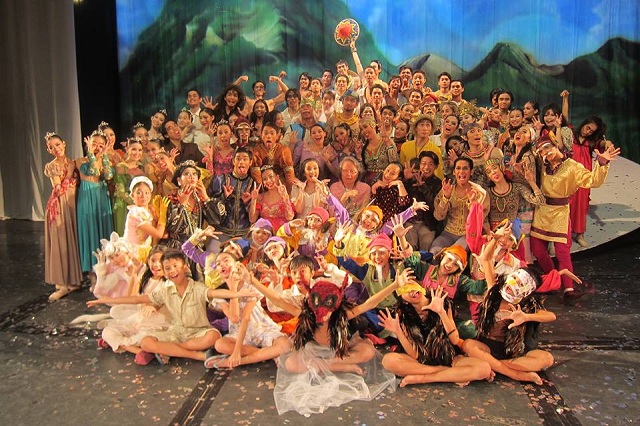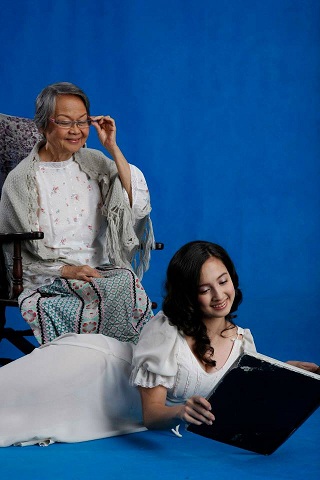Filtered By: Lifestyle
Lifestyle
Dance review: The magic of ballet and storytelling in 'Lola Basyang'
By RINA ANGELA CORPUS

The cast of 'Tatlo Pang Kuwento ni Lola Basyang.' All photos courtesy of Ballet Manila
The classic children's stories of Severino Reyes set to dance should be enough enticement to watch Ballet Manila's "Tatlo Pang Kuwento ni Lola Basyang," the company's opener for its 18th season.
The production, a sequel to 2009's "Tatlong Kuwento ni Lola Basyang," uses three stories from Anvil Publishing's version of the Lola Basyang book series: "Labindalawang Masasayang Prinsesa," "Ang Palasyo ng mga Duwende" and "Anting-Anting."
It is also a glimpse of Ballet Manila artistic director Lisa Macuja-Elizalde's mission of bringing "ballet to the people." Filipinizing ballet, after all, would make it more relatable and engaging for a broader local audience beyond the cultural elite who are the usual patrons of most traditional ballet performances.
 Entering Aliw Theater to watch this ballet indeed proved to show just that: the theater was packed with rowdy children and teens from the provinces, so much so that veteran actress Luz Fernandez herself, while enacting Lola Basyang, kept reminding the young audience, with all-motherly mien, to observe silence as part of theater etiquette.
Entering Aliw Theater to watch this ballet indeed proved to show just that: the theater was packed with rowdy children and teens from the provinces, so much so that veteran actress Luz Fernandez herself, while enacting Lola Basyang, kept reminding the young audience, with all-motherly mien, to observe silence as part of theater etiquette.
Fernandez was a most apropos performer for Lola Basyang, as she herself played the iconic grandmother-storyteller role in the '80s TV children's fantasy series “Ora Engkantada.” Her emphatic voice and countenance are endearingly familiar to Pinoy viewers who grew up watching her in the series. She has aged, but still has the wit and charm of a doting grandmother whose passion is to entertain grandkids with stories that are filled with learnings and values.
The idea of a story within a story also added enchantment to the show.
Macuja-Elizalde's daughter, Missy Elizalde, played Ate Missy with much ebullience and charm. She sat with three other children at Lola Basyang's feet, listening to her story which was spoken in the vernacular. Ate Missy served as the link between the storyteller and the dance scenes as she jeted her way from Lola Basyang's space to the world of spectacle and dance at the start of each story.
The first dance was “Labindalawang Masasayang Prinsesa.” Chiefly choreographed by Macuja-Elizalde with input from three other Ballet Manila dancers, it featured fairly simple dancing using classical ballet, with traditional adagios and codas for the princesses' and princes' parts. There was also comic variation in the scenes with the princesses' father, Hari (played by Marcus Tolentino), the motherly Infanta (Jonathan Janolo) and the white cat (alternately played by two children). While set in a Western royal court, the ballet interestingly had very Pinoy elements in terms of costume colors—the fiesta standards of fuchsia pink, loud green, and bright red and yellow. And though the set design attempted to show an ornate palace setting, it was not so sophisticated compared to, say, sets used in ballet productions at the Cultural Center of the Philippines.
 But what added interest to this story ballet was the use of Original Pilipino Music—"Kailangan Kita" and "Ikaw ang Lahat sa Akin"—put together by musical arranger Arnold Buena.
But what added interest to this story ballet was the use of Original Pilipino Music—"Kailangan Kita" and "Ikaw ang Lahat sa Akin"—put together by musical arranger Arnold Buena.
Macuja-Elizalde played the eldest of the king's 12 daughters, who would secretly leave their bedroom at night to visit an enchanted land to dance with enchanted princes. There were no pyrotechnics that wowed the audience in the dancing, nor in the entire choreography. It was a simple ballet that was quite straightforward and unembellished with virtuoso steps.
The second story, "Ang Palasyo ng mga Dwende," showed the most appeal and promise among the three ballets, with an interesting choreographic ensemble by the company's resident choreographer Gerardo Francisco, a former dance master of Dagyaw Theater and Dance Company in Mindanao.
Francisco incorporated neo-ethnic movements reminiscent of the Mindanao lumad and the ancient Pintados, set to the richly layered music of Diwa de Leon, who is known for his venture into the hegalong, a two-stringed native lute.
In this story, willowy Marika Capati convincingly played the heroine Yani, victimized by her envious and scheming stepmother and stepsister. Capati is a vibrant dancer, delivering her steps with much emotion and warmth. The cursed bird that is changed back into a prince, with the help of Yani, is beautifully essayed by Romeo Peralta, the company's senior soloist.
An added heartwarming delight are the dwarves, mostly played by little children, who oozed cuteness as they danced their parts using steps from pop culture, though some appeared to be comic variations of the itik-itik folk dance. The ballet was also helped by aerial theater machines that lifted some key dancers upwards, including the enchanted bird-prince.
 The last ballet, "Anting-Anting," is a horror-fantasy-comedy featuring Huan, a cowardly hero who wants to overcome his fears in order to win the maiden he loves. Michael Divinagracia, a look-alike of comedian Jose Manalo, jovially interpreted the character. The entire dance involved much acting from the dancers and had all the elements of slapstick comedy, what with the use of exaggerated, boisterous movements to portray how Huan is bullied by the young townsmen, who kept challenging him to overcome his fears. The setting was provincial, with a bahay kubo and a traditional sari-sari store. The men were dressed in farmer's clothing, and the ladies in kimona and saya.
The last ballet, "Anting-Anting," is a horror-fantasy-comedy featuring Huan, a cowardly hero who wants to overcome his fears in order to win the maiden he loves. Michael Divinagracia, a look-alike of comedian Jose Manalo, jovially interpreted the character. The entire dance involved much acting from the dancers and had all the elements of slapstick comedy, what with the use of exaggerated, boisterous movements to portray how Huan is bullied by the young townsmen, who kept challenging him to overcome his fears. The setting was provincial, with a bahay kubo and a traditional sari-sari store. The men were dressed in farmer's clothing, and the ladies in kimona and saya.
The dance ended with a farcical scene where Huan finds himself haunted by ghosts inside a cemetery as he tries to acquire an anting-anting.
This promising venture of Ballet Manila with Anvil Publishing is one way to popularize Philippine children's literature, using dance to add another layer of artistic delight for young audiences, who are now increasingly lured by today's technological devices. With the mounting influence of the internet and hi-tech gadgets, it is refreshing to go back to the magic of reading and listening to age-old tales that provide lessons that may fill us once more with hardiness and wisdom. — BM, GMA News
Ballet Manila's "Tatlo Pang Kuwento ni Lola Basyang" runs at Aliw Theater until Sept. 27.
Rina Angela Corpus is an assistant professor at the Department of Art Studies, University of the Philippines. Her research interests include feminist aesthetics, dance history and alternative spiritualities. She trained with the Quezon City Ballet and Limon Dance Institute in New York. You may visit her writings at Dance of Stillness.
The production, a sequel to 2009's "Tatlong Kuwento ni Lola Basyang," uses three stories from Anvil Publishing's version of the Lola Basyang book series: "Labindalawang Masasayang Prinsesa," "Ang Palasyo ng mga Duwende" and "Anting-Anting."
It is also a glimpse of Ballet Manila artistic director Lisa Macuja-Elizalde's mission of bringing "ballet to the people." Filipinizing ballet, after all, would make it more relatable and engaging for a broader local audience beyond the cultural elite who are the usual patrons of most traditional ballet performances.

Luz Fernandez as Lola Basyang and Missy Macuja Elizalde as Ate Missy
Fernandez was a most apropos performer for Lola Basyang, as she herself played the iconic grandmother-storyteller role in the '80s TV children's fantasy series “Ora Engkantada.” Her emphatic voice and countenance are endearingly familiar to Pinoy viewers who grew up watching her in the series. She has aged, but still has the wit and charm of a doting grandmother whose passion is to entertain grandkids with stories that are filled with learnings and values.
The idea of a story within a story also added enchantment to the show.
Macuja-Elizalde's daughter, Missy Elizalde, played Ate Missy with much ebullience and charm. She sat with three other children at Lola Basyang's feet, listening to her story which was spoken in the vernacular. Ate Missy served as the link between the storyteller and the dance scenes as she jeted her way from Lola Basyang's space to the world of spectacle and dance at the start of each story.
The first dance was “Labindalawang Masasayang Prinsesa.” Chiefly choreographed by Macuja-Elizalde with input from three other Ballet Manila dancers, it featured fairly simple dancing using classical ballet, with traditional adagios and codas for the princesses' and princes' parts. There was also comic variation in the scenes with the princesses' father, Hari (played by Marcus Tolentino), the motherly Infanta (Jonathan Janolo) and the white cat (alternately played by two children). While set in a Western royal court, the ballet interestingly had very Pinoy elements in terms of costume colors—the fiesta standards of fuchsia pink, loud green, and bright red and yellow. And though the set design attempted to show an ornate palace setting, it was not so sophisticated compared to, say, sets used in ballet productions at the Cultural Center of the Philippines.

Joan Emery Sia, Jan Erika Sinchioco Basilio and Eileen Lopez in 'Ang Palasyo ng mga Dwende'
Macuja-Elizalde played the eldest of the king's 12 daughters, who would secretly leave their bedroom at night to visit an enchanted land to dance with enchanted princes. There were no pyrotechnics that wowed the audience in the dancing, nor in the entire choreography. It was a simple ballet that was quite straightforward and unembellished with virtuoso steps.
The second story, "Ang Palasyo ng mga Dwende," showed the most appeal and promise among the three ballets, with an interesting choreographic ensemble by the company's resident choreographer Gerardo Francisco, a former dance master of Dagyaw Theater and Dance Company in Mindanao.
Francisco incorporated neo-ethnic movements reminiscent of the Mindanao lumad and the ancient Pintados, set to the richly layered music of Diwa de Leon, who is known for his venture into the hegalong, a two-stringed native lute.
In this story, willowy Marika Capati convincingly played the heroine Yani, victimized by her envious and scheming stepmother and stepsister. Capati is a vibrant dancer, delivering her steps with much emotion and warmth. The cursed bird that is changed back into a prince, with the help of Yani, is beautifully essayed by Romeo Peralta, the company's senior soloist.
An added heartwarming delight are the dwarves, mostly played by little children, who oozed cuteness as they danced their parts using steps from pop culture, though some appeared to be comic variations of the itik-itik folk dance. The ballet was also helped by aerial theater machines that lifted some key dancers upwards, including the enchanted bird-prince.

Michael Divinagracia in 'Anting-Anting'
The dance ended with a farcical scene where Huan finds himself haunted by ghosts inside a cemetery as he tries to acquire an anting-anting.
This promising venture of Ballet Manila with Anvil Publishing is one way to popularize Philippine children's literature, using dance to add another layer of artistic delight for young audiences, who are now increasingly lured by today's technological devices. With the mounting influence of the internet and hi-tech gadgets, it is refreshing to go back to the magic of reading and listening to age-old tales that provide lessons that may fill us once more with hardiness and wisdom. — BM, GMA News
Ballet Manila's "Tatlo Pang Kuwento ni Lola Basyang" runs at Aliw Theater until Sept. 27.
Rina Angela Corpus is an assistant professor at the Department of Art Studies, University of the Philippines. Her research interests include feminist aesthetics, dance history and alternative spiritualities. She trained with the Quezon City Ballet and Limon Dance Institute in New York. You may visit her writings at Dance of Stillness.
More Videos
Most Popular




